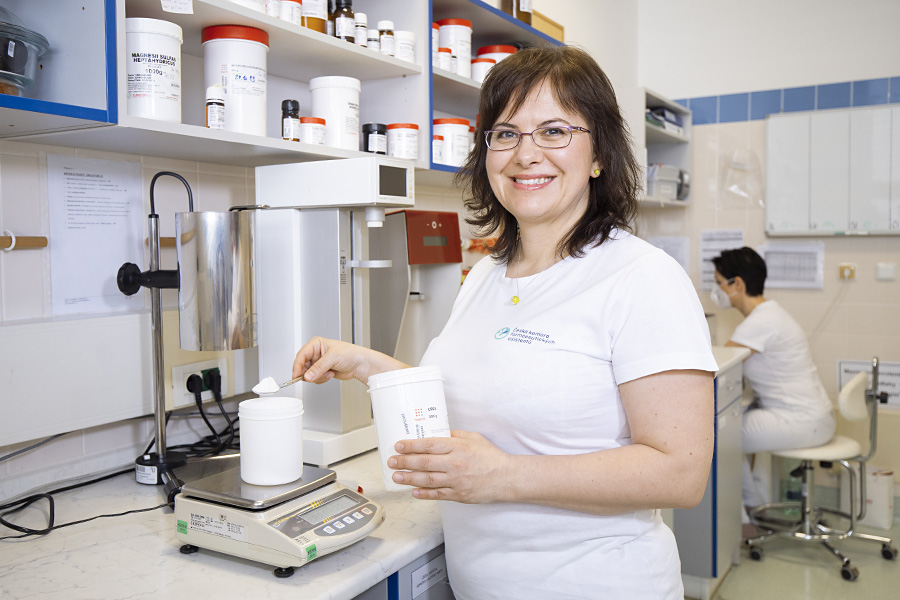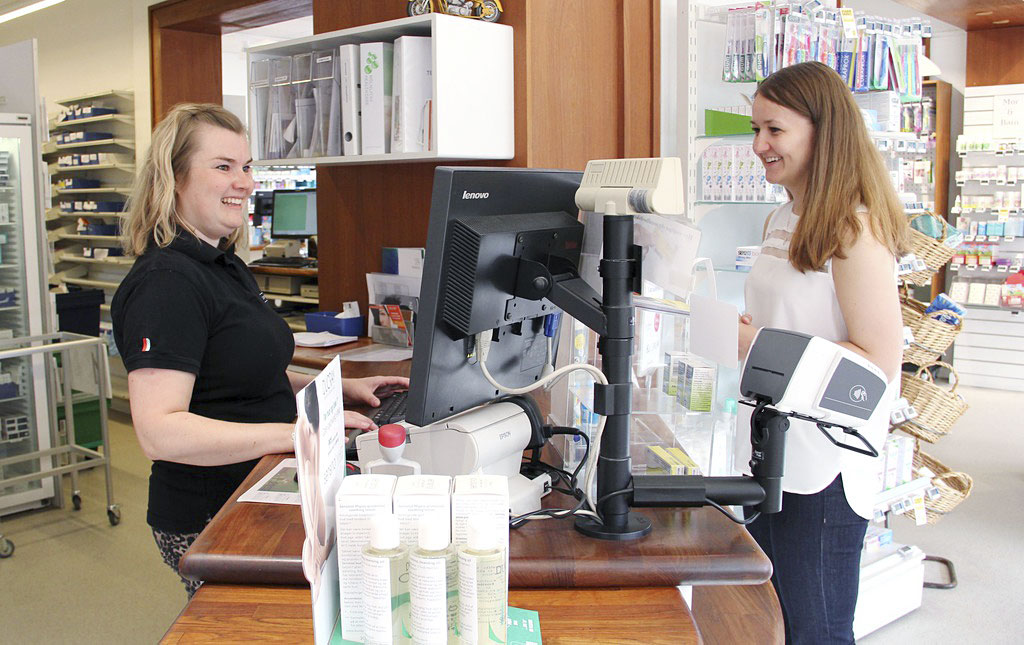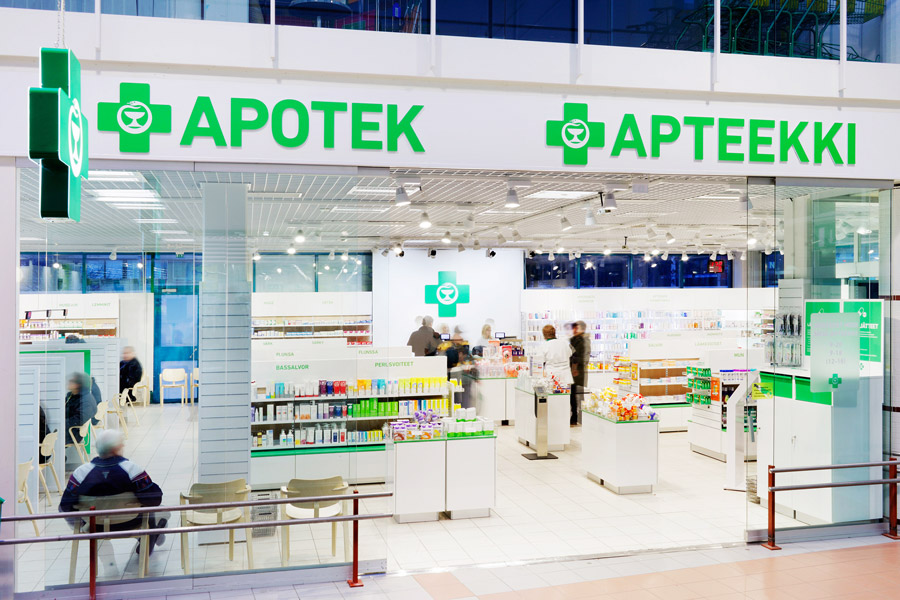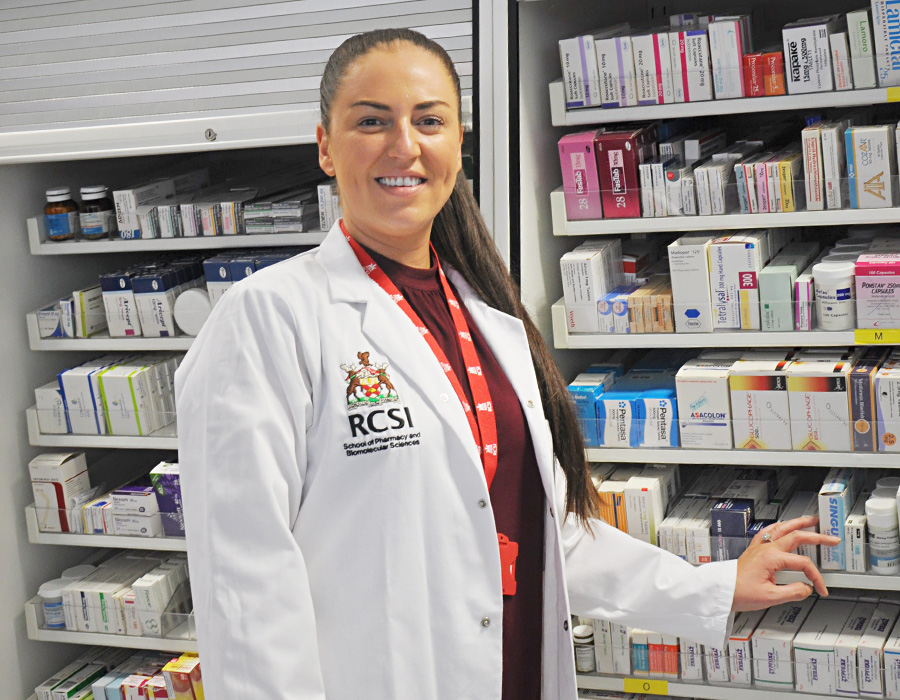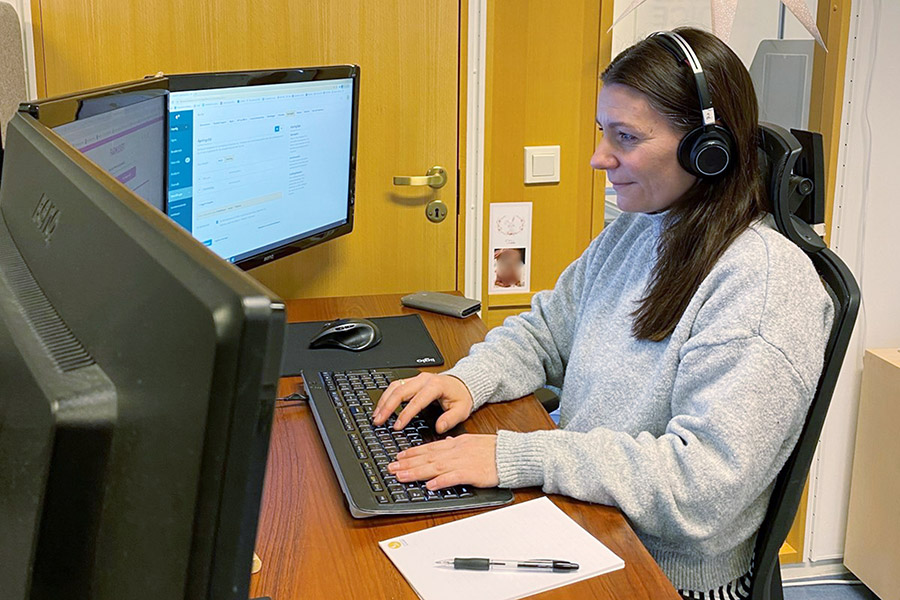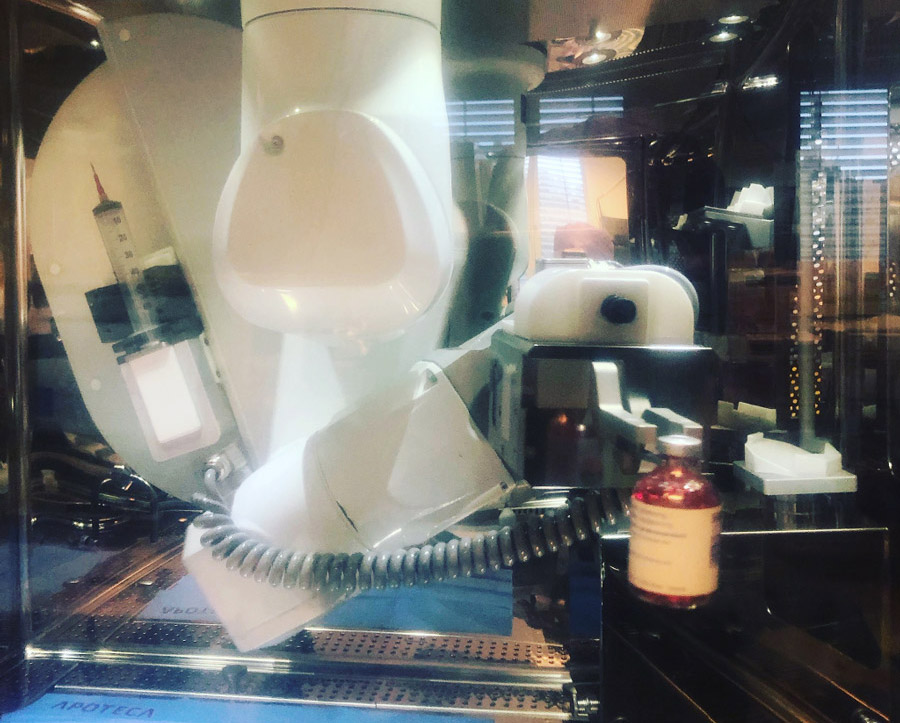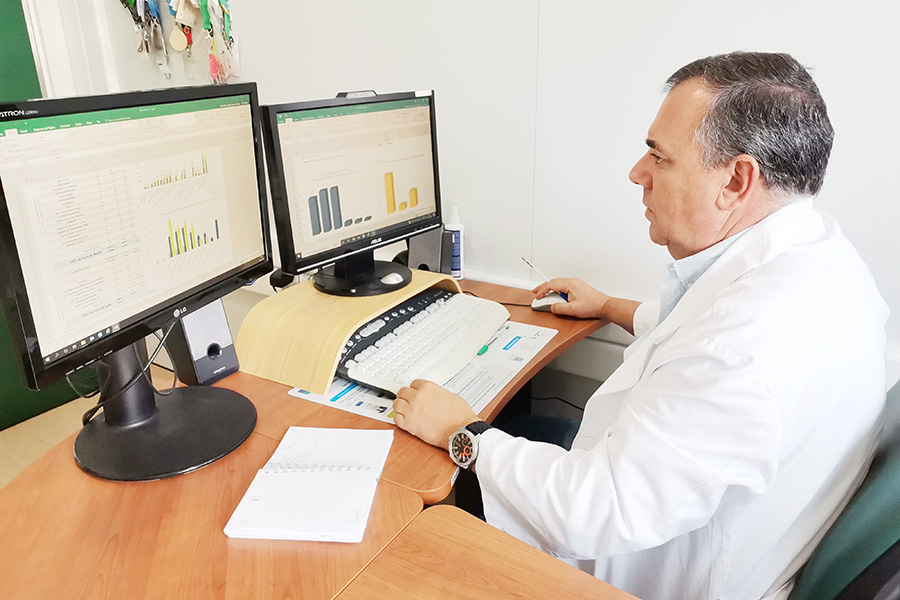Norway’s first filling robot for chemotherapy drugs is hard at work at the Hospital Pharmacy Production Unit at the Norwegian Radium Hospital. The Italian donna has been given the name Monte Bella, and according to reports she is capable, beautiful and a little strict.
By: Kristin Rosmo
As we exit the elevator on the seventh floor we are greeted by an orange, spiral-shaped “person” on the expansive white wall in front of us. The head of Hospital Pharmacy Production Unit at the Norwegian Radium Hospital, Lise Raanes Rødøy, enthuses over the brand new artwork by Farnoosh Shahamatdar.
“The idea is to illustrate that, here, humans, science and technology work closely together,” she explains, before opening the door to the bright and attractive premises that her unit moved into at the start of the year.
Profitability and production
We are currently in the new OCCI building at the Norwegian Radium Hospital. OCCI, or Oslo Cancer Cluster Innovasjonspark, is a research-based industry cluster for biomedical cancer diagnostics and treatment. The unit’s main task is the production of chemotherapy drugs and antibodies used to treat patients with cancer at the Norwegian Radium Hospital and Oslo University Hospital. Often, the patients have to undergo highly specialised courses of treatment.
“We create many special treatment doses with various excipients and we produce around 26,000 treatment doses each year,” says Raanes Rødøy.
At the moment, the unit is also participating in around 60 clinical studies involving the preparation of substances for trial treatment; chemotherapy drugs, antibodies and vaccines. The department employs 12 pharmacy technicians, ten pharmacists and two operators.
In connection with the decision to relocate the production unit from the basement of the Hospital Pharmacy to the new premises in the OCCI building, the Hospital Pharmacy's board decided to procure a chemotherapy drugs robot for the unit. Following an extensive, international tendering process for the contract – which was worth millions – a robot known as Apoteca Chemo, manufactured by the Italian company Loccioni, was selected.
“The procurement agreement also includes an option to purchase a further two robots of the same type. If you break it down, the technical investment is not the largest single cost. When we look at the profitability of the project, we also need to consider the fact that personnel resources in connection with a tendering process of this nature and implementation total around double the technical cost. Our aim is for all our investments to be profitable within eight years,” explains Bente Hayes, project owner and operations manager for the Hospital Pharmacies.
The Italian robot was quickly named Monte Bella
“The choice of named was obvious. The Norwegian Radium Hospital is located in an area known as Montebello in the westernmost part of Oslo. High up on the seventh floor it almost feels as though you are in the mountains, or on the ‘monte’ as the Italians would say. Seeing as the robot is Italian, and stunning to boot, it was obvious that she should be called ‘Monte Bella’. When she is being especially good, we refer to her simply as ‘Bella’,” adds unit manager Raanes Rødøy.
The result of the contract with the Italian company materialised last spring, when Monte Bella soared into the premises.
“She could not very well take the elevator up. At 1.4 tonnes she is a rather hefty lady, and in order to get her into place we needed to construct special scaffolding and remove the façade. It was spectacular, but the whole process was very smooth,” recounts Kristoffer Olavesen, advisor to the Hospital Pharmacy and project engineer for the Monte Bella project.
Monte Bella is Norway’s first filling robot for chemotherapy drugs. She does have a robot colleague in Copenhagen that has been producing chemotherapy drugs for many years. The robot signorina relies heavily on collaboration with human colleagues in order to be able to do what is expected of her. Two such colleagues are pharmacy technicians and superusers Irene Ovland and Torhild Sandboe Sauro.
Superusers with solid experience
“It is wonderfully exciting to be a part of something that is completely new here in Norway. It is quite simply a bit of an honour. I never really thought that I would ever get an opportunity like this, and I feel honoured that I am trusted to be a superuser on this project,” says Sandboe Sauro.
Four years ago, having spent 26 years working in the same pharmacy in Strømmen, Sandboe Sauro began looking for change and new challenges, and she certainly got her wish. Fellow superuser Ovland has been working at the Hospital Pharmacy’s production unit for 14 years.
“I have many years’ experience of preparing chemotherapy drugs, but doing it with the help of a robot is completely new to me. It is great to see what technology is capable of, and I am very impressed by Monte Bella’s performance,” she says.
Both superusers recently turned 50 and feel that it is great to have been given the opportunity to learn something completely new at a mature age.
A beautiful and clever colleague
Last autumn was all about ensuring that Monte Bella met all the relevant quality requirements before she was allowed to commence regular production,
“The autumn was spent on installing data, technical checks and validating the production process. The validation has also involved testing the purity of the production chamber itself and ensuring that the robot complies with GMP (Good Manufacturing Practice) standards. We had to burn the midnight oil quite a bit, but Monte Bella passed all the tests,” confirms the project engineer.
Olavesen has been heading up the validation work together with an Italian engineer. The staff received training on how to use Monte Bella around the new year, during which period the Italian project manager was available.
“Learning how to use the robot has been both exciting and challenging. The Italian project manager who has been in charge of training is a very good teacher and easy to understand. Most of the training has been conducted in English,” he says.
The two superusers gush shamelessly about their new colleague, who they have become fond of despite the fact that she can be a little strict from time to time.
“Monte Bella does not accept errors. She alerts us by making beeping noises,” explains Ovland.
The unit’s new addition is nevertheless capable of recognising all substances by measuring the height and weight of the vials. To make absolutely sure that the substance is correct, she also uses image recognition technology. In order for the weight parameter to be correct, the density of all the substances is also recorded in the database. She also knows when the first vial injection was made, how long the vial may be used once opened and how much of the substance remains inside.
“Once she has finished she presents the results to us and asks us to check, for example, that all dry components have been dissolved properly. She performs all these operations with the most feminine and elegant flair,” says Sandboe Sauro.
HSE and patient safety improvements
It looks set to be a busy year for Monte Bella. The unit produces around 100 chemotherapy bags each day.
“We estimate that Monte Bella will initially be capable of shouldering around 20 per cent of the unit’s total production. This figure will increase gradually to reach our target of 60 per cent automation. In order to achieve this we rely on the new regional ordering system which forms part of the digital renewal project for the South-Eastern Norway Regional Health Authority. We believe that this will be in place by 2017. By then we will have reached our target,” concludes unit manager Raanes Rødøy.
She believes that the expensive investment will pay off over time. In addition, the investment is important to patient safety, HSE and the prevention of operator strain injuries.
“My experience so far is that work positions have improved and the strain has been reduced. I spent many years working on manual production in an isolator and I have developed strain injuries to my neck and shoulders as a result. Now, I spend only a minimum of time sitting down and my work positions are completely different. I also get some relief when it comes to certain operations such as the filling of syringes,” says Ovland.
No need to fear for jobs
This winter the Norwegian dailies have been running a series of articles focusing on how, in the future, robots will be able to both improve and obfuscate our professional and our personal lives. In an article in Aftenposten, Infuture partner Camilla Tepfers asks the burning question: ‘As robots become increasingly intelligent, isn’t there a risk that they might take over our jobs?”. Not necessarily, according to Tepfers. She believes that robots complement humans by taking on work where human resources are insufficient, working side by side with us to relieve some of the strain associated with, for example, heavy lifting or dangerous or demanding operations. These views are reflected by the superusers at the Hospital Pharmacy Production Unit at the Norwegian Radium Hospital.
“Monte Bella will not make us redundant. We will always need pharmacy technicians to operator her, together with a pharmacist. She has been a positive addition to our workplace and she has enabled us to look at our profession in a completely new light. We are ready to work in partnership with technology,” says Sandboe Sauro, carefully and confidently executing Monte Bella’s shut-down procedure on this February day.

